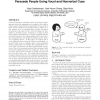5054 search results - page 3 / 1011 » How designers design and program interactive behaviors |
CHI
2006
ACM
14 years 5 months ago
2006
ACM
People display adaptive language behaviors in face-to-face conversations, but will computer users do the same during HCI? We report an experiment (N=20) demonstrating that users&#...
ICSE
1997
IEEE-ACM
13 years 9 months ago
1997
IEEE-ACM
Implementing, validating, modifying, or reengineering an object-oriented system requires an understanding of the object and class interactions which occur as a program executes. T...
HRI
2012
ACM
12 years 11 days ago
2012
ACM
Social robots have to potential to serve as personal, organizational, and public assistants as, for instance, diet coaches, teacher’s aides, and emergency respondents. The succe...
HICSS
2003
IEEE
13 years 10 months ago
2003
IEEE
Health communication researchers have shown that tailored health communication messages outperform nontailored materials. Non-tailored materials are typically “one-size-fits-all...
FDL
2004
IEEE
13 years 8 months ago
2004
IEEE
System-on-Chip (SOC) and other complex distributed hardware/software systems contain heterogeneous components such as DSPs, micro-controllers, application specific logic etc., whi...



